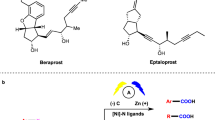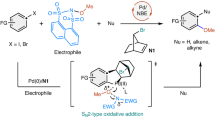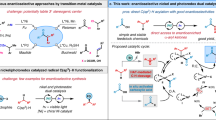Abstract
Although carbon dioxide (CO2) is an attractive renewable carbon source, its utilization to produce fine chemicals through the catalytic carboxylation of unactivated carbon–hydrogen (C–H) bonds is still very limited and remains a challenge, largely because CO2 is thermodynamically and kinetically stable. In particular, the generation of (hetero)aromatic carboxylic acids via a transition-metal-catalysed C–H carboxylation of arenes with CO2 is extremely rare. Here we report a ligand-enabled site-selective carboxylation of 2-arylphenols under atmospheric pressure of CO2 through a Rh2(OAc)4-catalysed and chelation-assisted C–H bond activation. Remarkably, the reaction occurs selectively on the less nucleophilic phenyl group with the promotion of a phosphine ligand, which overrides the site selectivity dictated by the well-known Kolbe–Schmitt type reaction. The non-acidic C–H bonds within several important classes of heterocycles were also efficiently carboxylated with this method. A mechanistic investigation revealed complexes of active catalysts and that this reaction proceeds under redox-neutral reaction conditions.

This is a preview of subscription content, access via your institution
Access options
Access Nature and 54 other Nature Portfolio journals
Get Nature+, our best-value online-access subscription
$29.99 / 30 days
cancel any time
Subscribe to this journal
Receive 12 digital issues and online access to articles
$119.00 per year
only $9.92 per issue
Buy this article
- Purchase on Springer Link
- Instant access to full article PDF
Prices may be subject to local taxes which are calculated during checkout



Similar content being viewed by others
Change history
29 April 2020
In the originally published PDF version of this Article, corresponding author information was missing for author Gang Li. This includes an email address in the affiliations section on the first page, and a line instructing readers who to address ‘correspondence and requests for materials’ to, on the final page. These have now been updated.
References
Aresta, M., Dibenedetto, A. & Angelini, A. Catalysis for the valorization of exhaust carbon: from CO2 to chemicals, materials, and fuels. Technological use of CO2. Chem. Rev. 114, 1709–1742 (2014).
Liu, Q., Wu, L., Jackstell, R. & Beller, M. Using carbon dioxide as a building block in organic synthesis. Nat. Commun. 6, 5933 (2015).
Dalton, D. M. & Rovis, T. C–H carboxylation takes gold. Nat. Chem. 2, 710–711 (2010).
Ackermann, L. Transition-metal-catalyzed carboxylation of C–H bonds. Angew. Chem. Int. Ed. 50, 3842–3844 (2011).
Brill, M., Lazreg, F., Cazin, C. S. J. & Nolan, S. P. Transition metal-catalyzed carboxylation of organic substrates with carbon dioxide. Top. Organomet. Chem. 53, 225–278 (2015).
Zhang, L. & Hou, Z. N-Heterocyclic carbene (NHC)–copper-catalysed transformations of carbon dioxide. Chem. Sci. 4, 3395–3403 (2013).
Börjesson, M., Moragas, T., Gallego, D. & Martin, R. Metal-catalyzed carboxylation of organic (pseudo)halides with CO2. ACS Catal. 6, 6739–6749 (2016).
Huang, K., Sun, C.-L. & Shi, Z.-J. Transition-metal-catalyzed C–C bond formation through the fixation of carbon dioxide. Chem. Soc. Rev. 40, 2435–2452 (2011).
Luo, J. & Larrosa, I. C–H carboxylation of aromatic compounds through CO2 fixation. ChemSusChem 10, 3317–3332 (2017).
Juliá-Hernández, F., Moragas, T., Cornella, J. & Martin, R. Remote carboxylation of halogenated aliphatic hydrocarbons with carbon dioxide. Nature 545, 84–88 (2017).
Seo, H., Katcher, M. H. & Jamison, T. F. Photoredox activation of carbon dioxide for amino acid synthesis in continuous flow. Nat. Chem. 9, 453–456 (2017).
Masuda, Y., Ishida, N. & Murakami, M. Light-driven carboxylation of o-alkylphenyl ketones with CO2. J. Am. Chem. Soc. 137, 14063–14066 (2015).
Michigami, K., Mita, T. & Sato, Y. Cobalt-catalyzed allylic C(sp 3)–H carboxylation with CO2. J. Am. Chem. Soc. 139, 6094–6097 (2017).
Sasano, K., Takaya, J. & Iwasawa, N. Palladium(ii)-catalyzed direct carboxylation of alkenyl C–H bonds with CO2. J. Am. Chem. Soc. 135, 10954–10957 (2013).
Li, Y., Yan, T., Junge, K. & Beller, M. Catalytic methylation of C–H bonds using CO2 and H2. Angew. Chem. Int. Ed. 53, 10476–10480 (2014).
Gooßen, L. J., Rodríguez, N., Manjolinho, F. & Lange, P. P. Synthesis of propiolic acids via copper-catalyzed insertion of carbon dioxide into the C−H bond of terminal alkynes. Adv. Synth. Catal. 352, 2913–2917 (2010).
Yu, D. & Zhang, Y. Copper- and copper–N-heterocyclic carbene-catalyzed C–H activating carboxylation of terminal alkynes with CO2 at ambient conditions. Proc. Natl Acad. Sci. USA 107, 20184–20189 (2010).
Zhang, W.-Z., Li, W.-J., Zhang, X., Zhou, H. & Lu, X.-B. Cu(i)-catalyzed carboxylative coupling of terminal alkynes, allylic chlorides, and CO2. Org. Lett. 12, 4748–4751 (2010).
Yu, B. et al. Carboxylation of terminal alkynes at ambient CO2 pressure in ethylene carbonate. Green. Chem. 15, 2401–2407 (2013).
Lindsey, A. S. & Jeskey, H. The Kolbe–Schmitt reaction. Chem. Rev. 57, 583–620 (1957).
Fenner, S. & Ackermann, L. C–H carboxylation of heteroarenes with ambient CO2. Green. Chem. 18, 3804–3807 (2016).
Luo, J., Preciado, S., Xie, P. & Larrosa, I. Carboxylation of phenols with CO2 at atmospheric pressure. Chem. Eur. J. 22, 6798–6802 (2016).
Banerjee, A., Dick, G. R., Yoshino, T. & Kanan, M. W. Carbon dioxide utilization via carbonate-promoted C–H carboxylation. Nature 531, 215–219 (2016).
Zhang, Z. et al. Lactamization of sp 2 C–H bonds with CO2: transition-metal-free and redox-neutral. Angew. Chem. Int. Ed. 55, 7068–7072 (2016).
Zhang, Z. et al. Transition-metal-free lactonization of sp 2 C–H bonds with CO2. Org. Lett. 19, 396–399 (2017).
Wang, S., Shao, P., Du, G. & Xi, C. MeOTf- and TBD-mediated carbonylation of ortho-arylanilines with CO2 leading to phenanthridinones. J. Org. Chem. 81, 6672–6676 (2016).
Yoo, W.-J., Capdevila, M. G., Du, X. & Kobayashi, S. Base-mediated carboxylation of unprotected indole derivatives with carbon dioxide. Org. Lett. 14, 5326–5329 (2012).
Vechorkin, O., Hirt, N. & Hu, X. Carbon dioxide as the C1 source for direct C−H functionalization of aromatic heterocycles. Org. Lett. 12, 3567–3569 (2010).
Olah, G. A. et al. Efficient chemoselective carboxylation of aromatics to arylcarboxylic acids with a superelectrophilically activated carbon dioxide−Al2Cl6/Al system. J. Am. Chem. Soc. 124, 11379–11391 (2002).
Ukai, K., Aoki, M., Takaya, J. & Iwasawa, N. Rhodium(i)-catalyzed carboxylation of aryl- and alkenylboronic esters with CO2. J. Am. Chem. Soc. 128, 8706–8707 (2006).
Ohishi, T., Nishiura, M. & Hou, Z. Carboxylation of organoboronic esters catalyzed by N-heterocyclic carbene copper(i) complexes. Angew. Chem. Int. Ed. 47, 5792–5795 (2008).
Yeung, C. S. & Dong, V. M. Beyond Aresta’s complex: Ni- and Pd-catalyzed organozinc coupling with CO2. J. Am. Chem. Soc. 130, 7826–7827 (2008).
Williams, C. M., Johnson, J. B. & Rovis, T. Nickel-catalyzed reductive carboxylation of styrenes using CO2. J. Am. Chem. Soc. 130, 14936–14937 (2008).
Correa, A. & Martin, R. Palladium-catalyzed direct carboxylation of aryl bromides with carbon dioxide. J. Am. Chem. Soc. 131, 15974–15975 (2009).
Fujihara, T., Nogi, K., Xu, T., Terao, J. & Tsuji, Y. Nickel-catalyzed carboxylation of aryl and vinyl chlorides employing carbon dioxide. J. Am. Chem. Soc. 134, 9106–9109 (2012).
Zhang, X. et al. Silver(i)-catalyzed carboxylation of arylboronic esters with CO2. Chem. Commun. 48, 6292–6294 (2012).
Tran-Vu, H. & Daugulis, O. Copper-catalyzed carboxylation of aryl iodides with carbon dioxide. ACS Catal. 3, 2417–2420 (2013).
Shimomaki, K., Murata, K., Martin, R. & Iwasawa, N. Visible-light-driven carboxylation of aryl halides by the combined use of palladium and photoredox catalysts. J. Am. Chem. Soc. 139, 9467–9470 (2017).
Boogaerts, I. I. F. & Nolan, S. P. Carboxylation of C–H bonds using N-heterocyclic carbene gold(i) complexes. J. Am. Chem. Soc. 132, 8858–8859 (2010).
Boogaerts, I. I. F., Fortman, G. C., Furst, M. R., Cazin, C. S. J. & Nolan, S. P. Carboxylation of N–H/C–H bonds using N-heterocyclic carbene copper(i) complexes. Angew. Chem. Int. Ed. 49, 8674–8677 (2010).
Zhang, L., Cheng, J., Ohishi, T. & Hou, Z. Copper-catalyzed direct carboxylation of C−H bonds with carbon dioxide. Angew. Chem. Int. Ed. 49, 8670–8673 (2010).
Inomata, H., Ogata, K., Fukuzawa, S. & Hou, Z. Direct C–H carboxylation with carbon dioxide using 1, 2, 3-triazol-5-ylidene copper(i) complexes. Org. Lett. 14, 3986–3989 (2012).
Mizuno, H., Takaya, J. & Iwasawa, N. Rhodium(i)-catalyzed direct carboxylation of arenes with CO2 via chelation-assisted C–H bond activation. J. Am. Chem. Soc. 133, 1251–1253 (2011).
Suga, T., Mizuno, H., Takaya, J. & Iwasawa, N. Direct carboxylation of simple arenes with CO2 through a rhodium-catalyzed C–H bond activation. Chem. Commun. 50, 14360–14363 (2014).
Suga, T., Saitou, T., Takaya, J. & Iwasawa, N. Mechanistic study of the rhodium-catalyzed carboxylation of simple aromatic compounds with carbon dioxide. Chem. Sci. 8, 1454–1462 (2017).
Luo, S., Luo, F.-X., Zhang, X.-S. & Shi, Z.-J. Synthesis of dibenzopyranones through palladium-catalyzed directed C–H activation/carbonylation of 2-arylphenols. Angew. Chem. Int. Ed. 52, 10598–10601 (2013).
Albano, P., Aresta, M. & Manassero, M. Interaction of carbon dioxide with coordinatively unsaturated rhodium(i) complexes with the ligand 1,2-bis(diphenylphosphino)ethane. Inorg. Chem. 19, 1069–1072 (1980).
Kuhl, N., Schröder, N. & Glorius, F. Formal SN-type reactions in rhodium(iii)-catalyzed C–H bond activation. Adv. Synth. Catal. 356, 1443–1460 (2014).
Kim, M., Kwak, J. & Chang, S. Rhodium/N-heterocyclic carbene catalyzed direct intermolecular arylation of sp 2 and sp 3 C-H bonds with chelation assistance. Angew. Chem. Int. Ed. 48, 8935–8939 (2009).
Fiorani, G., Guo, W. & Kleij, A. W. Sustainable conversion of carbon dioxide: the advent of organocatalysis. Green. Chem. 17, 1375–1389 (2015).
Pope, B. M., Yamamoto, Y. & Tarbell, D. S. Di-tert-butyl dicarbonate. Org. Syn. 57, 45–50 (1977).
Neog, K., Borah, A. & Gogoi, P. Palladium(ii)-catalyzed C–H bond activation/C–C and C–O bond formation reaction cascade: direct synthesis of coumestans. J. Org. Chem. 81, 11971–11977 (2016).
Wu, Y., Chen, Z., Yang, Y., Zhu, W. & Zhou, B. Rh(iii)-catalyzed redox-neutral unsymmetrical C–H alkylation and amidation reactions of N-phenoxyacetamides. J. Am. Chem. Soc. 140, 42–45 (2018).
Tan, Y. & Hartwig, J. F. Palladium-catalyzed amination of aromatic C–H bonds with oxime esters. J. Am. Chem. Soc. 132, 3676–3677 (2010).
Muzart, J. N,N-Dimethylformamide: much more than a solvent. Tetrahedron 65, 8313–8323 (2009).
Tran, B. L., Li, B., Driess, M. & Hartwig, J. F. Copper-catalyzed intermolecular amidation and imidation of unactivated alkanes. J. Am. Chem. Soc. 136, 2555–2563 (2014).
Acknowledgements
We gratefully acknowledge the financial support from the Strategic Priority Research Program of the Chinese Academy of Sciences (Grant no. XDB20000000), Natural Science Foundation of Fujian (2017J06007, 2017J05038), NSFC (Grant nos 21702206 and 21402198), the 100 Talents Program of Fujian Province, the National 1000 Youth Talents Program and the State Key Laboratory of Structural Chemistry.
Author information
Authors and Affiliations
Contributions
L.F. and S.L. performed the experiments and developed the reactions. S.L. did the mechanistic studies. Z.C. helped to develop the reaction of 2-pyridinylphenol. Y.D. helped to prepare the substrates. X.-Q.G., D.Y. and Q.-F.S. collected and analysed the X-ray crystallography data. L.-P.Z. collected the high-resolution mass spectra data of the complexes. G.L. designed and supervised the project and wrote the manuscript with feedback from L.F., S.L. and Z.C.
Corresponding author
Ethics declarations
Competing interests
The authors declare no competing interests.
Additional information
Publisher’s note: Springer Nature remains neutral with regard to jurisdictional claims in published maps and institutional affiliations.
Supplementary information
Supplementary Information
Supplementary Methods; Supplementary Tables 1–7; Supplementary References; Supplementary Figures 1–98
CIF file for compound 5
Crystallographic data for compound 5, CCDC reference 1819284
CIF file for compound 6
Crystallographic data for compound 6, CCDC reference 1819415
Rights and permissions
About this article
Cite this article
Fu, L., Li, S., Cai, Z. et al. Ligand-enabled site-selectivity in a versatile rhodium(ii)-catalysed aryl C–H carboxylation with CO2. Nat Catal 1, 469–478 (2018). https://doi.org/10.1038/s41929-018-0080-y
Received:
Accepted:
Published:
Issue Date:
DOI: https://doi.org/10.1038/s41929-018-0080-y
This article is cited by
-
Visible-light-driven synthesis of N-heteroaromatic carboxylic acids by thiolate-catalysed carboxylation of C(sp²)–H bonds using CO2
Nature Synthesis (2024)
-
Regioselective umpolung para-C–H functionalization of arylhydroxylamines
Nature Synthesis (2023)
-
Electrochemical reactor dictates site selectivity in N-heteroarene carboxylations
Nature (2023)
-
Two prime or not two prime
Nature Catalysis (2018)



